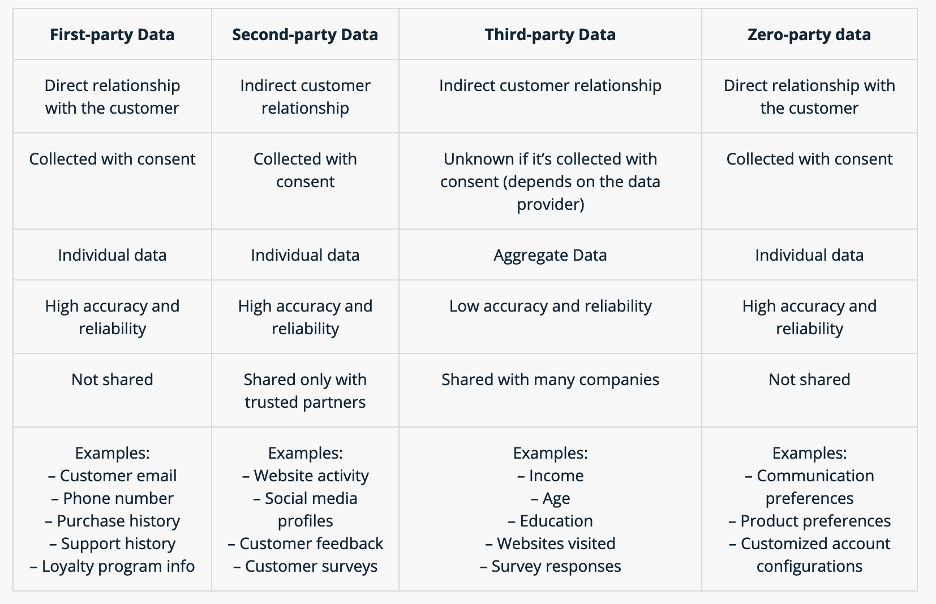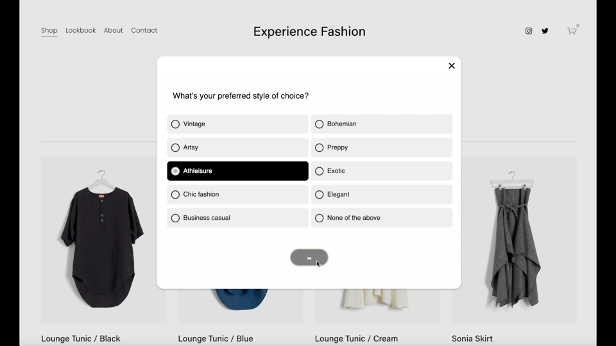As online data privacy rises in the public consciousness, businesses are feeling the need to update their thinking and cater to consumer expectations around the handling of sensitive data.
Many are moving away from legacy data collection methods like third-party cookies and second-party data partnerships and seeking alternative options.
There is growing awareness that personal data is being used without explicit permission and that the information we provide is being aggregated and shared in ways that reveal more than we intend if we do give consent. As a result, consumers are demanding more privacy and expressing concern over how their data is used – even to the extent of cutting off contact with brands whose privacy policies they disagree with.
What’s more, personal data rights are enshrined in law in a growing number of places. For example, new data protection and privacy regulations like Europe’s GDPR (General Data Protection Regulation) and the state of Vermont’s Security Breach Notice Act, make it more difficult for companies to use other types of data for personalisation in marketing.
However, there’s a new kid on the block: zero-party data.
These stringent regulations don’t apply to zero-party data, and it’s seen as a promising alternative for online marketers and businesses that still want to use consumer data to shape decisions around their marketing strategy.
It’s a phrase we’re hearing more and more, especially when it comes to personalisation, but what is zero-party data? What does it mean for your business? And most importantly, can you take advantage of its potential?
Start Tracking & Seeing Results In Your Zero-party Data
Zero-party data definition
The term ‘zero-party data’ was first popularised by Forrester; they published a report on its potential as an alternative source of customer data.
In the report, they define zero-party data as: “Data that a customer intentionally and proactively shares with a brand.”
Put simply, information that we (as customers) share with organisations.
But to make sense of zero-party data, it’s helpful to understand the other kinds of customer data that are commonly used for marketing and personalisation.
● First-party data
This is customer data collected by companies and organisations via their websites, apps and other platforms and services. It’s often behavioural – meaning that it’s generated by what users do on websites or inside apps and platforms. It includes website activity like what links were opened, how long was spent on pages, hovering, scrolling and other session information. It also includes information like what someone has purchased or what kinds of things they’re interested in, based on their searches and navigation.
First-party data provides companies with valuable information about user interests and purchase intentions. Thanks to cookie notifications and privacy policies on the websites and apps they use, it’s likely that most people are aware to some extent that companies use their data to provide personalisation and improve services, although it’s collected passively rather than being voluntarily provided by the user.
● Second-party data
With second-party data, a company will collect data from its customer base via its own channels, social media, survey data and other sources, and then sell it to other companies as a commodity. In this sense, your second-party data is someone else’s first-party data.
The advantage of second-party data for businesses is that they can expand their knowledge using data from another business with which they have a specific relationship. This means they know where the data is coming from and they can be sure that it pertains to the types of consumers they’re interested in. However, the customer may not be aware that their data has been sold to another business, and often will not have given explicit consent for it to be used this way.
● Third-party data
Third-party data is purchased by companies from outside sources. These sources are generally data aggregators who pull together data from multiple places and package it up together for sale. third-party data includes things like demographic information, CMS data and POS system data. Like second-party data, it’s often collected and used without the explicit consent of the person it concerns.
● Zero-party data
Enter the new kid on the block: zero-party data, also known as explicit data. zero-party data differs from the other types of data we’ve mentioned in that the customer or individual has knowingly given the data to the company that will use it. The customer gives the data actively, ‘above and beyond’ the passive first-party data sources like browsing and purchasing behaviour.
The customer intentionally gives zero-party data to the company because its use will benefit them in some way, such as to make recommendations based on their product preferences, to deliver personalised content or to adhere to communication preferences. It’s a kind of quid pro quo or value exchange arrangement.

Why is zero-party data such a hot topic?
One of the main reasons why zero-party data is such a hot topic is because tech leaders are moving away from tracking in general.
Apple has tightened up its anti-tracking stance, adding stronger data protection features on its hardware, and Google has announced plans to eradicate third party cookies from its Chrome browser, a change timetabled for 2023.
Where Google and Apple go, the rest of the internet tends to follow. And with some experts ringing the death knell for third party cookies, businesses are understandably looking for ways to future-proof their personalised campaigns and content and make sure they provide a positive experience for website visitors and app users. To many, zero-party data looks like the best way forward.
But since the stringent new regulations don’t apply to zero-party data, it’s seen as a promising alternative for online marketers and businesses that still want to use consumer data to shape decisions around their marketing strategy.
How can zero-party data benefit your business?
zero-party data has been called ‘the new oil’ by Forbes because of its huge potential for new kinds of personalisation. As well as being better for consumer privacy, voluntarily supplied information promises several benefits over other data types, particularly third-party data.
For example:
● It’s more trustworthy
When a customer provides personal data willingly to a business, they are more likely to tell the truth about themselves, their preferences, and behaviours. When you know how your data is used, there’s less temptation to falsify it to gain access to a service. By moving towards zero-party data, you’re meeting customers’ expectations of privacy and increasing their trust in your brand.
● It’s explicit, not implied
With zero-party data, you know an individual’s preferences because they have told you about them. Other types of data rely on inference. For example, you can assume that someone is interested in soccer because third-party data shows they have visited several sports websites, and make predictions about their purchase intentions based on that assumption. In reality, that person might have no interest in soccer, but they lent their device to a soccer-mad family member or shopped for a gift for someone sporty.
● It’s more accurate
Customer data that has come directly from the person who owns it has less chance of being inaccurate. It hasn’t passed through multiple systems, been aggregated or reproduced, so it’s less likely to be out of date when it reaches you.
● It leads to better personalisation
When businesses and their customers are on the same page about how personal data will be used, there’s a greater chance that the results will be high in quality and value. It becomes significantly easier to tailor experiences (especially if you have a customer data platform to leverage insights) and create unique pathways for visitors and customers.
Where does zero-party data come from?
Zero-party data collection can cover a wide range of sources, including
- Surveys
- Quizzes
- Forms
- Interactive tools and funnels
- Ranking and rating buttons and sliders
- Social media platforms
- Transactional data
- New customers’ registration details
In many cases, the way zero-party data is collected segues naturally with the interactive nature of online life, and it may be enjoyable and interesting for customers to take a quiz, fill in a personal profile or take a survey about things they like. Done the right way, collecting zero-party data can help customers feel listened to, known and valued.
Therefore, it makes sense to integrate zero-party data collection methods in a way that’s seamless and natural. The easier the experience is, the more likely customers will be to engage with your listening tools.

Personalisation with zero-party data
Using zero-party data to personalise experiences and content differs from using the large volumes available with, for example, third-party data. With zero-party data, there’s less of it, but it’s higher in quality and more complete.
Businesses that don’t pay attention to the experience of collecting zero-party data are at risk of overwhelming their users with too many information requests. Make sure you collect zero-party data in a personal context, using engaging experiences that are not too onerous to complete and are clearly linked to user benefits – remember, it’s a transaction where personal data is exchanged for a personalised benefit.
Invest in high-quality listening and feedback technology that will make the process smoother for both you and your customers. With the right kind of data collection and analytics, you can gather high-quality data and quickly turn it into actionable recommendations that will help improve your customer offering.
Compared with first-party, second-party, and third-party data, zero-party data is more likely to be provided in the form of written and even spoken language, because it comes directly from your customers, often in their own words. Being able to process natural language to learn from zero-party data is an avenue worth exploring, and there’s every chance it will become an essential part of doing business in the near future.
Find out how we can better connect you with your customers
With Qualtrics Customer Preference Collection XM Solution, it becomes possible for brands and businesses to collect the preference information customers are willing to share.
This data flows directly into Experience ID, our intelligent database that pulls all experience and operational data shared by customers — structured, unstructured, CDP and preferences — and organises it into unique data profiles that show a 360-degree view of each customer’s journey.
What this means is that you can start to provide more personalised experiences at scale based on what your customers want and need. Through it, you can:
- Develop deeper customer relationships at scale, and build your pipeline with high-quality leads based on genuine interests and preference
- Deliver elegant and integrated experiences that fit into the context of each customer journey, including targeted email campaigns and personalised offers
- Engage with end users and deliver personalised experiences in real-time, meeting ever-changing demands and preferences
It’s time to supercharge your customer profiles by collecting preference data at every opportunity and delivering meaningful content recommendations in real-time.
Start Tracking & Seeing Results In Your Zero-party Data